Window replacement rarely makes sense from purely an energy perspective. If you have already improved your insulation, performed air-and-duct sealing, and have moderately to highly efficient heating and cooling equipment— a of which are typically more cost—effective upgrades—windows would be the last weak link in the thermal performance of a house.
Of course, there are many other reasons to replace windows. Ease of cleaning and maintenance, aesthetics, damage or rot on the existing windows, and general remodeling are all non-energy-related factors that contribute to the value of window replacement. However, here I’ll specifically address the energy features and performance values you should consider when assessing the cost and benefits of new or replacement windows.
According to Code
Many energy codes apply not only to new construction and additions, but also contain energy requirements for remodeling and replacement windows. Recent model codes, for example, require a maximum NFRC-rated U-factor of 0.4, or 0.35 for all replacement windows in most cold climates. If you choose Energy Star—rated windows for your house, they will probably meet or exceed local code requirements, but it’s always a good idea to check with your local building official to make sure.
Climate Matters!
For a resident of Miami, Florida, living in a house with typical single-pane aluminum windows, more than half of the cooling bill may be due to the windows.
However, changing to insulated glass (yet keeping aluminum frames) will save less than 5% on annual cooling costs. On the other hand, replacing them with vinyl windows with Low-e insulated glass and gas fill may save 24% or more on the cooling bill.
If you are considering upgrading your air-conditioning system, you may first want to upgrade your windows. Window performance has a large impact on cooling loads and can affect an air conditioner’s operating efficiency. If you size a new or replacement air conditioner based on regular glass and later change to insulated Low-e glazing, you will actually hurt the air conditioner’s efficiency by decreasing the cooling load. If, on the other hand, you change the glass first, you can save money by installing a smaller air-conditioning unit.
Choosing windows
Determining the right combination of window features and price is a complex undertaking, which is further complicated by climate differences. Broadly speaking, when you choose windows, you need to consider function (daylight, glare, egress, ventilation, and maintenance); aesthetics; energy performance (heat loss, UV transmission, condensation control, comfort, and solar gain); and warranty.
I will not say much about the functional qualities of windows, other than to point out that investments in maintenance features—such as vinyl or aluminum cladding on wood windows or tilt—out sash for easy cleaning—can easily pay for themselves with saved hassle and expense. They speak for themselves. For all those criteria, as with most products, you get what you pay for—with windows, at least as much as with other products, it is worth buying the best you can afford.
As for energy performance, I consider double- pane, Low-c glass an absolute minimum requirement for all climates. Next, avoid aluminum frames. Although still popular in some areas because of their low profile and durability aluminum frames have a much higher degree of conductivity and are more prone to condensation, which promotes mold growth. Wood, vinyl, and fiberglass frames generally have lower U-factors (an indicator of conductive heat loss) and lower solar heat gain coefficient (SHGC) ratings than those of aluminum frames (with similarly glazed windows).Those are generally beneficial qualities in any climate.
Beyond those basic guidelines, the two primary characteristics to consider are a window’s U-factor and SHGC. In cold climates, you should generally buy the lowest U-factor you can afford -- that will save you the most on heating costs. In those cases, gas fills are generally desirable, and extra layers of heat mirror film are great, if you can afford them. Don’t buy a product with a U-factor above 0.35; the best products on the market are rated at about 0.15.
In hot climates, the U-factor is secondary to SHGC—in those case, buy the lowest SHGC available to reduce air-conditioning loads. Tinted glass or spectrally selective Low-c coatings help reduce unwanted heat gain without impacting visibility. Choose a product with a visible transmittance (VT) that is higher than the SHGC rating. Try to select products with SHGC ratings below 0.4; the lowest rated products have an SHGC of about 0.2.Another specification for glass is the light-to-solar gain (LSG) ratio. In hot climates, high LSG means good heat rejection with minimal impact on view and daylight. Look for the highest LSG products, and never buy windows with an LSG less than 1.0.
In a mixed climate, you’ll want to compromise between the U-factor and the SHGC. Generally, a low U-factor combined with a low SHGC is desirable. One complication in northern and mixed climates is solar gain. South-facing windows provide free heat gain in winter and add little to the cooling load in summer.
In cold or mixed climates, varying SHGC ratings in a house can really maximize energy efficiency High-SHGC for south-facing windows maximizes free solar heating in winter. Low-SHGC for east- and west-facing windows, which produce most summer heat gain, minimizes air— conditioning loads. Some manufacturers sell products aimed at northern or southern climates, and you can order matching windows with different glass for different orientations. As long as the low-SHGC glass is not tinted, you’ll never see the difference. Mixing window specifications takes some careful planning and a special order, but it can usually be done at little or no extra cost.
If you are comfortable with a computer and really want to optimize your window choices, get some help calculating the benefits of different specifications with free window-energy software called RESFEN (available free on the Internet users at this site) . The detailed calculations are a little slow; but the inputs are fairly simple. RESFEN provides results in annual beating and cooling dollars attributed to your windows, so you can compare the differences between product costs and likely annual savings and calculate your payback period. Be careful to accurately input your electric and gas utility rates if they are different from the defaults supplied.
Alternatively, you can hire a Home Energy Rater or other building-performance consultant to help you calculate the cost—effectiveness of various options. Those professionals are more likely to understand the nuances of U-factor and SHGC (and are less likely to be biased) than the average window—replacement salesperson.
TIP: In northern and mixed climates, south-facing windows can provide free heat gain in winter, while adding little to the cooling load in summer.
Caution: South-facing windows are a great benefit in cold climates, providing free heat and ample light in winter, but some houses have far too much. Glass area to the south should not exceed 7% of the floor area of the house, unless you have properly designed thermal mass to absorb the excess energy. If there is too much south-facing glass, the space will overheat when the sun shines, and the excess glazing will add to heat loss at night and on cold, cloudy days. Very low U-factors with low SHGC can compensate, but it’s better (and cheaper) to replace excess glazing with insulated walls.
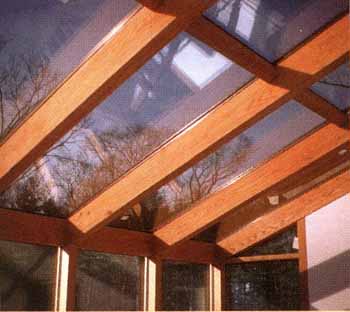
This south-facing overhead glass provides free passive
solar heat, but it overheats the room when the sun shines and loses
too much heat when the sun doesn’t.

A tilt-out sash is one useful feature found in replacement
windows.
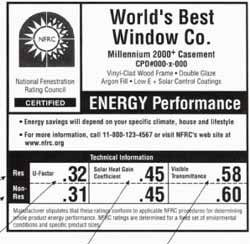
NFRC Window Label
The Notional Fenestration Rating Council (NFRC) is a non profit, public/private organization created by the window, door, and skylight industry. The NFRC has established a voluntary national energy-performance rating and labeling system for fenestration products, which is typically the best way to compare true energy performance of windows. This label can be found on most new window products -- many states mandate NFRC listing for energy code compliance, and virtually all major manufacturers have their products rated. (The information on the label is typically also available in manufacturers’ catalogs; the NFRC product directory is also available online at www.nfrc.org). Note that the numerical values shown are for the entire window unit, including the glass, sash, and frame, and they make it easy to do energy calculations for any window of known dimensions.
Residential size: Use this row for the “average” residential window. The exact sizes of Res and Non-Res vary by window type.
Commercial size: Only use this row if you’re buying a really big window.
The “U-factor” (U = I /R) represents conductive heat loss—smaller is better.
Double Low-e windows typically range from 0.3 to 0.4; clear double glass is typically 0.5 to 0.55; and aluminum-frame, single-glazed windows can be over 1.
Solar heat gain coefficient—SHGC— is the amount of direct solar radiant heat that gets in through the window. Lower SHGC reduces summer cooling loads, but higher SHGC increases solar heat gain in winter. Most windows fall between 0.3 and 0.6 on this 0-to-1 scale.
Visible Transmittance—VT—is o measure of how much visible light gets through. Lower VT means reduced glare, but also less night time visibility. Most windows fall between 0.4 and 0.6 on this 0-to-1 scale.

EPA’s Energy Star Window Regions: The U.S.
Environmental Protection Agency (EPA) rates numerous household
appliances and other energy-using products in its Energy Star labeling
program. Here, windows are rated for better-than-average performance
in three climates. The requirements for Energy Star windows include:
double, low-e glass in all areas; in the northern U.S., a U-factor
of 0.35 or less and nonmetal frames; in the central U.S., a U-factor
of 0.4 or less, an SHGC of 0.55 or less, and metal or nonmetal frames;
in the southern U.S., a U-factor of 0.75 or less, an SHGC of 0.4 or
less, and metal or nonmetal frames. For more information, check out
the Energy Star Web site at www.energystar.gov; click on “find products.”
Windows Sell
In an admittedly unscientific survey of two Yellow Pages directories in my area, one listed seven times as many replacement-window contractors and dealers as it did insulation contractors (the other listed three times as many window dealers). Neither one had a listing for “Air-sealing” or “Building performance,” but both had a small handful of businesses listed under “Energy Management and Consulting’ which would probably be a good place to look for someone who can give whole-house recommendations.
Replacement sash
When you do decide to replace your windows, there are two basic approaches: replacing the entire window, including the frame, or replacing just the sash. Sash replacement is usually accomplished with a unit that includes a new frame to carry the replacement sash. The frame fits in the pocket between the old stops. This approach is less expensive and involves a lot less trim work, but most products are limited to double-hung styles. If you choose that approach, keep in mind that the added frame thickness will slightly reduce the glass area and view. Some kits include only the sash, jamb liners, and hardware, without the integral frames. They are trickier to install well, though they tend to look more like original windows.
You must accurately measure the dimensions of the existing frames, then order replacement units that will fit properly Check both the height and the width in several places, in case the jambs are not parallel, and use the shortest distance for ordering purposes. If your existing window frames are badly out of square, replacement-sash or pocket kits will never fit properly If the side frames are bowed inward, it may indicate that the window frame is carrying loads from above due to inadequate header support. Either of these conditions requires replacing the entire window. In the latter case, you may need to make significant structural repairs as well. Check the old frame carefully for moisture damage, and remember that a damaged sill can indicate that water has leaked into the wall beyond the window frame.
If you are replacing old double-hung windows that have rope-and-pulley sashes, be sure to remove the old steel weights and insulate the pockets before installing the new windows. One way to do this is by pulling a length of fiberglass batt into the pocket. If you are removing the old trim, seal the pockets with low-expansion foam. Be careful not to fill too much, because it may distort the frames.
As you insert the frames, carefully follow the manufacturer’s instructions for shimming and sup porting them, and be sure to carefully caulk any gaps between the new frame and the old before installing the trim. Don’t use foam between the frames, unless the new frames are very sturdy and well supported. If the gaps are large, tuck in backer rod to fill the spaces, then caulk.
One detail that is especially important is the flashing of any new window frame, which keeps any wind-driven rain that gets past the siding or leaks in the window frame from seeping into the wall cavity. You can only flash if you replace the entire window. Also, pay attention to the instructions for trim installation and exterior caulking details. For example, the gap where a new sill sits on top of the old one is generally left unsealed to allow any water that penetrates to drain freely.
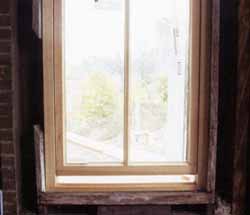
In old, double-hung windows, the spaces in which the counterweights
run are potential voids in the wall insulation, and they tend to be
drafty. If you are removing the interior trim or plaster, the pockets
can easily be sealed with spray foam.
TIP: If you decide to replace your windows, there are two basic approaches— replacing the entire window (including the frame) or replacing must the sash.
Caution:
Don’t try to second-guess the downsizing adjustment between the inside dimensions an existing window frame and the frame dimensions of the replacement sash or pocket. Buy window kits from a reputable lealer who is experienced in the replacement business and let him or her do the figuring. Otherwise, you may end up with gaps that are too big to be covered by the trim -- and lots of headaches.
Note: Some people are concerned about argon gas leaking through glass and wasting their investment, but this is largely a myth. Studies have shown that the vast majority of gas loss issue to poor design or assembly if the edge seals. In well-built units, gas loss results in just a few-percent change in the window’s performance over a 20-year lifetime. By the time the seals fail and fill the unit with moisture, no one will care about the performance of the gas fill.
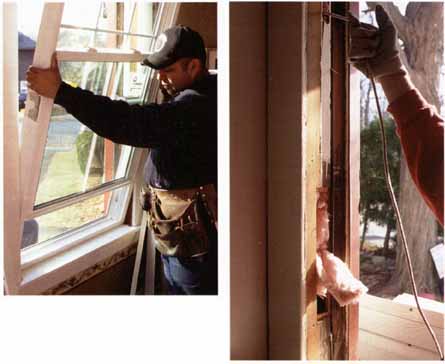
Many replacement windows can be set into the existing window
frame, minimizing disruption to the interior and exterior trim. If
you are replacing only the sash, you can use a short length of rope
and snake a strip of fiberglass batt into the weight pocket.
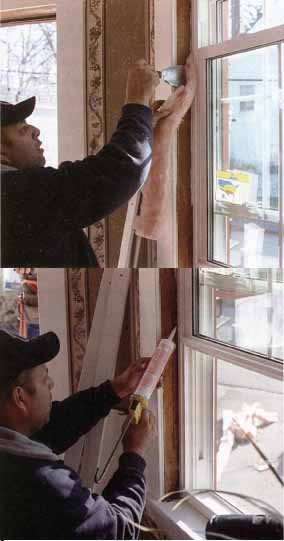
above: Before attaching the stops, caulk the frame
of a new window to the old frame to ensure a good, airtight seal. below:
Tucking in a strip of fiberglass helps ensure a good fit, but the gap
must still be caulked afterward to make an airtight seal.
Drafty Windows
Most people assume that their windows leak through the spaces around and between the sash. And some windows do leak pretty badly; old, rattling
double-hung or aluminum horizontal sliders tend to be the worst. But often it’s the space between the window and the rough opening that needs to be sealed. This space is normally covered by casings on the interior and the exterior, and, depending on how tight the casings are, a lot of air may leak through that area. If you aren’t otherwise removing the trim, the easiest way to seal those leaks is to caulk the casings where they meet the wall and the jamb—use paintable, siliconized acrylic caulk here. If you are replacing windows or removing the trim for any other reason (or if it’s easy to remove), use low-expansion foam.
Another misconception is that insulation R-value is important here, I have seen instructions that suggest how important it is to tuck little tufts of fiberglass gently into the jamb space; that will do nothing to stop air movement. The conductive heat loss through an entire window is probably 10 times greater than that through a small plug of foam around it, as long as you stop the air from leaking. Use low-expansion foam and make sure it bridges the gap completely. Don’t use too much foam; if the gap is large, first fill most of the space with a piece of rigid-foam insulation.

When foaming around a new window, be sure to use a light
touch (left), or you’ll end up with problems. The window opening shown
above was sealed with low-expanding foam, but the space was so large
that the foam distorted the window frame as it cured. This window probably
won’t open without some remedial work.
TIP: Replacing an entire window frame offers you the opportunity to inspect the framing, correct water damage, and air-seal the new window.
Before installing adhesive vinyl v-seal weather-stripping on your windows, make sure the surfaces are as clean as possible. Don’t depend on the adhesive to hold it in place. It’s a good idea to drive a few light-gauge staples every 12 in. or so (through only the back half). The upper sash may already be painted shut; if you don’t need to use it, you may want to caulk around the edge to seal it.
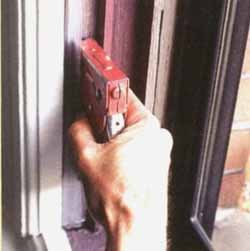
Don’t depend on the adhesive to hold this weather-stripping
in place. Peel it back and staple the backing to the frame at least
every 12 in.

This spongy foam rope, called backer rod, can be used to
fill large gaps between a window frame and the rough opening. It is
available in various diameters and should be caulked in place so it
seals well. Backer rod is avail able at home centers; from masonry-supply
dealers; and through energy efficiency suppliers, such as EFI.